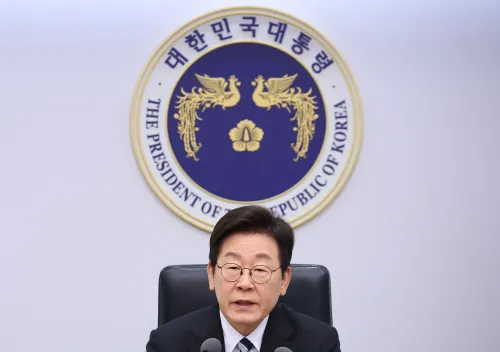Did North Korea Successfully Test Two Hypersonic Projectiles?

Synopsis
Key Takeaways
- North Korea tested two hypersonic projectiles, enhancing military capabilities.
- The launches are part of a broader defense strategy.
- South Korea observed multiple missile launches preceding the hypersonic tests.
- The hypersonic technology poses challenges for interception.
- Regional tensions are heightened ahead of the APEC summit.
Seoul, Oct 23 (NationPress) North Korea announced on Thursday that it has successfully conducted tests on two hypersonic projectiles, referring to them as a new "significant" weapon system. The country stated that these advanced missiles bolster its war deterrence capabilities.
"Two hypersonic projectiles were launched from the Ryokpho District in Pyongyang Municipality, targeting the northeastern direction, successfully hitting the designated target area on the tableland of Kwesang Peak located in Orang County, North Hamgyong Province," reported the Korean Central News Agency (KCNA).
This test, executed the day prior by the Missile Administration, is part of a defense strategy aimed at enhancing the sustainability and effectiveness of its strategic deterrence against potential adversaries, according to the KCNA.
On the same day, South Korea's military reported that North Korea had launched multiple short-range ballistic missiles northeastward around 8:10 a.m., which traveled approximately 350 kilometers.
Military sources indicated that the projectiles might have been the tactical ballistic missile known as the Hwasongpho-11-Da-4.5, which North Korea tested last September. Reports suggest these missiles landed inland, avoiding the East Sea.
Notably, North Korean leader Kim Jong-un did not attend Wednesday's test. Instead, Pak Jong-chon, secretary of the Central Committee of the Workers' Party of Korea (WPK), along with other officials, supervised the launch.
Kim's absence supports the notion that the North has not yet completed its technological advancements for the Hwasong-11Ma, which was first revealed during a military parade earlier this month.
Pak emphasized that the new state-of-the-art weapon system is clear evidence of North Korea's continuous enhancement of its self-defensive capabilities and its commitment to strengthening war deterrence and self-defense.
He characterized the tested weapon as possessing "new strategic value".
This recent ballistic missile launch marks the first occurrence of its kind since South Korean President Lee Jae Myung took office in June and the first missile provocation in approximately five months, as reported by Yonhap news agency.
This display of military strength comes just a week before South Korea is set to host the Asia-Pacific Economic Cooperation (APEC) summit in Gyeongju on October 31-November 1.
South Korea's military and the unification ministry have refrained from providing additional insights regarding the launch's timing.
However, a military official noted that North Korea may still be refining its hypersonic missile technologies, as characteristics of the advanced missile, such as evasive maneuvering, were not evident in this launch.
A hypersonic missile is typically challenging to intercept with existing missile defense systems, traveling at speeds of at least Mach 5—five times the speed of sound—and designed to maneuver on unpredictable flight paths at low altitudes.
During a parliamentary audit session on Thursday, General Son Sug-rag, the Air Force chief of staff, indicated that further evaluation is required to determine if the launched missiles were indeed the Hwasong-11Ma.
Officials also mentioned that it is challenging to ascertain whether this latest launch was intended to convey any political message ahead of the APEC summit, considering that the leader did not supervise the launch personally and the country cited self-defense as its justification.









